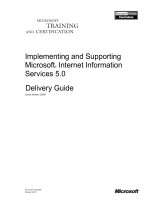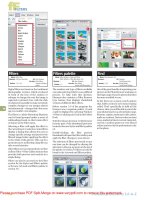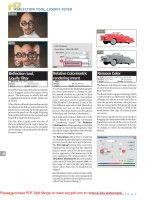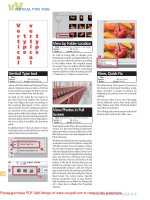Learning spring 5 0 build, test, and secure robust enterprise grade applications using the spring framework
Bạn đang xem bản rút gọn của tài liệu. Xem và tải ngay bản đầy đủ của tài liệu tại đây (4.6 MB, 343 trang )
Contents
1: Spring at Glance
b'Chapter 1: Spring at Glance'
b'Introduction to Spring framework'
b'Problems addressed by Spring'
b'Spring Architecture'
b'What more Spring supports underneath?'
b'Spring road map'
b'Container-The heart of Spring'
b'How beans are available from container?'
b'Summary'
2: Dependency Injection
b'Chapter 2: Dependency Injection'
b'The life of a bean'
b'Using JSR-250 annotations for bean lifecycle'
b'Instance creation'
b'Dependency Injection'
b'Summary'
3: Accelerate with Spring DAO
b'Chapter 3: Accelerate with Spring DAO'
b'How Spring handles database?'
b'Object Relation Mapping'
b'Summary'
4: Aspect Oriented Programming
b'Chapter 4: Aspect Oriented Programming'
b'Aspect Oriented Programming (AOP)'
b'Part I : Creating application for the core concern(JDBC)'
b'PartII: Integration of Log4J'
b'Part III: Writing Logging aspect.'
b'Annotation based aspect.'
b'Introduction'
5: Be Consistent: Transaction Management
b'Chapter 5: Be Consistent: Transaction Management'
b'Life cycle of transaction management'
b'Summary'
6: Explore Spring MVC
b'Chapter 6: Explore Spring MVC'
b''
b''
b'Summary'
7: Be assured take a test drive
b'Chapter 7: Be assured take a test drive'
b''Testing' an important step'
b'Testing Tools'
b'Pase I Unit testingDAO Unit testing by JUnit'
b'Mock Testing'
b'Pase II Integration testing'
b'Pase III System testing'
b'Summary'
8: Explore the Power of Restful Web Services
b'Chapter 8: Explore the Power of Restful Web Services'
b'Web services'
b'Summary'
9: Exchange the Message: The Messaging
b'Chapter 9: Exchange the Message: The Messaging'
b'Spring and Messaging'
b'Overview of WebSocket API'
b'SockJS'
b'STOMP'
b'Summary'
Chapter 1. Spring at Glance
Spring the fresh new start after the winter of traditional J2EE, is what Spring
framework is in actual. A complete solution to the most of the problems
occurred in handling the development of numerous complex modules
collaborating with each other in a Java enterprise application. Spring is not a
replacement to the traditional Java Development but it is a reliable solution to
the companies to withstand in today's competitive and faster growing market
without forcing the developers to be tightly coupled on Spring APIs.
In this topic, we will be going through the following points:
Introduction to Spring framework
Problems address by Spring in enterprise application development
Spring road map
What's new in Spring 5.0
Introduction to Spring framework
Rod Johnson is an Australian computer specialist and co-founder of
SpringSource. "Expert One on One J2EE Design and Development" was
published in November 2002 by him. This book contains about 30000 lines
of code, which contains the fundamental concepts like Inversion of Control
(IoC), Dependency Injection (DI) of the framework. This code is referred as
interface21. He wrote this code with just an intension to be used by
developers to simplify their work, or they can use this as basis of their own
development. He never thought of any framework development or anything
like that. There happened to be a long discussion at Wrox Forum about the
code, its improvement and lot many things. Juregen Holler and Yann
Caroffa,were the two readers of the forum who proposed the thought of
making the code a base of a new framework. This is the reasoning of Yann,
Spring the fresh new start after Winter of traditional J2EE who names the
framework as The Spring framework. The project went in public in June
2003 and powered towards 1.0. Then onwards lots of changes and up
gradations took place to withstand and support the technologies in market.
We aim in this book about the latest version 5.0. In couple of pages we will
cover what are the new features added in this version. In subsequent pages
we will cover how to use the latest features in your application and how as a
developer you can take advantages of.
Problems addressed by Spring
Java Platform is long term, complex, scalable, aggressive, and rapidly
developing platform. The application development takes place on a particular
version. The applications need to keep on upgrading to the latest version in
order to maintain recent standards and cope up with them. These applications
have numerous classes which interact with each other, reuse the APIs to take
their fullest advantage so as to make the application is running smoothly. But
this leads to some very common problems of as.
Scalability
The growth and development of each of the technologies in market is pretty
fast both in hardware as well as software. The application developed, couple
of years back may get outdated because of this growth in these areas. The
market is so demanding that the developers need to keep on changing the
application on frequent basis. That means whatever application we develop
today should be capable of handling the upcoming demands and growth
without affecting the working application. The scalability of an application is
handling or supporting the handling of the increased load of the work to adapt
to the growing environment instead of replacing them. The application when
supports handling of increased traffic of website due to increase in numbers
of users is a very simple example to call the application is scalable. As the
code is tightly coupled, making it scalable becomes a problem.
Plumbing code
Let's take an example of configuring the DataSource in the Tomcat
environment. Now the developers want to use this configured DataSource in
the application. What will we do? Yes, we will do the JNDI lookup to get the
DataSource. In order to handle JDBC we will acquire and then release the
resources in try catch. The code like try catch as we discuss here, inter
computer communication, collections too necessary but are not application
specific are the plumbing codes. The plumbing code increases the length of
the code and makes debugging complex.
Boiler plate code
How do we get the Connection while doing JDBC? We need to register
Driver class and invoke the getConnection() method on DriverManager to
obtain the connection object. Is there any alternative to these steps? Actually
NO! Whenever, wherever we have to do JDBC these same steps have to
repeat every time. This kind of repetitive code, block of code which
developer write at many places with little or no modification to achieve some
task is called as Boilerplate code. The boiler plate code makes the Java
development unnecessarily lengthier and complex.
Unavoidable non-functional code
Whenever application development happens, the developer concentrate on
the business logic, look and feel and persistency to be achieved. But along
with these things the developers also give a rigorous thought on how to
manage the transactions, how to handle increasing load on site, how to make
the application secure and many more. If we give a close look, these things
are not core concerns of the application but still these are unavoidable. Such
kind of code which is not handling the business logic (functional)
requirement but important for maintenance, trouble shooting, managing
security of an application is called as non-functional code. In most of the Java
application along with core concerns the developers have to write down nonfunctional code quite frequently. This leads to provide biased concentration
on business logic development.
Unit testing of the application
Let's take an example. We want to test a code which is saving the data to the
table in database. Here testing the database is not our motive, we just want to
be sure whether the code which we have written is working fine or not.
Enterprise Java application consists of many classes, which are
interdependent. As there is dependency exists in the objects it becomes
difficult to carry out the testing.
Spring, mainly addresses these problematic areas and provide a very
powerful yet easy solution with,
POJO based development
The class is a very basic structure of application development. If the class is
getting extended or implementing an interface of the framework, reusing it
becomes difficult as they are tightly coupled with API. The Plain Old Java
Object (POJO) is very famous and regularly used terminology in Java
application development. Unlike Struts and EJB Spring doesn't force
developers to write the code which is importing or extending Spring APIs.
The best thing about Spring is that developers can write the code which
generally doesn't has any dependencies on framework and for this, POJOs are
the favorite choice. POJOs support loosely coupled modules which are
reusable and easy to test.
Note
The Spring framework is called to be non-invasive as it doesn't
force the developer to use API classes or interfaces and allows to
develop loosely coupled application.
Loose coupling through DI
Coupling, is the degree of knowledge in class has about the other. When a
class is less dependent on the design of any other class, the class will be
called as loosely coupled. Loose coupling can be best achieved by interface
programming. In the Spring framework, we can keep the dependencies of
the class separated from the code in a separate configuration file. Using
interfaces and dependency injection techniques provided by Spring,
developers can write loosely coupled code (Don't worry, very soon we will
discuss about Dependency Injection and how to achieve it). With the help of
loose coupling one can write a code which needs a frequent change, due to
the change in the dependency it has. It makes the application more flexible
and maintainable.
Declarative programming
In declarative programming, the code states what is it going to perform but
not how it will be performed. This is totally opposite of imperative
programming where we need to state stepwise what we will execute. The
declarative programming can be achieved using XML and annotations.
Spring framework keeps all configurations in XML from where it can be
used by the framework to maintain the lifecycle of a bean. As the
development happened in Spring framework, the 2.0 onward version gave an
alternative to XML configuration with a wide range of annotations.
Boilerplate code reduction using aspects and templates
We just have discussed couple of pages back that repetitive code is
boilerplate code. The boiler plate code is essential and without which
providing transactions, security, logging etc will become difficult. The
framework gives solution of writing Aspect which will deal with such cross
cutting concerns and no need to write them along with business logic code.
The use of Aspect helps in reduction of boilerplate code but the developers
still can achieve the same end effect. One more thing the framework
provides, is the templates for different requirements. The JDBCTemplate,
HibernateTemplate are one more useful concept given by Spring which does
reduction of boilerplate code. But as a matter of fact, you need to wait to
understand and discover the actual potential.
Layered architecture
Unlike Struts and Hibernate which provides web persistency solutions
respectively, Spring has a wide range of modules for numerous enterprise
development problems. This layered architecture helps the developer to
choose any one or more of the modules to write solution for his application in
a coherent way. E.g. one can choose Web MVC module to handle web
request efficiently without even knowing that there are many other modules
available in the framework.
Spring Architecture
Spring provides more than 20 different modules which can be broadly
summaries under 7 main modules which are as follows:
Spring modules
Core modules
Core
Spring Core module supports ways of creating Spring beans and injecting the
dependencies in beans. It provide means to configure the beans and how to
obtain the configured beans from the Spring container using BeanFactory
and ApplicationCotext for developing standalone application
Beans
The Beans module provides BeanFactory which provides alternative for
programmatic singletons. The BeanFactory is an implementation of factory
design pattern.
Context
This module supports Java enterprise features such as EJB, JMX and basic
remoting. It supports for integration of third party libraries for caching, Java
Mailing and templating engines like Velocity.
SpEL
Spring Expression Language (SpEL) is an extension of unified Expression
Language which has be specified in JSP 2.1 specifications. SpEL module
supports setting and getting of property values, configuring collections using
logical as well as arithmetic operators, named variables from Spring IoC.
Data access and integration modules
JDBC(DAO)
This module provides abstraction layer on JDBC. It supports reduction of
boiler plate code which occurs in getting connection object via loading of
driver, getting statement object and many more. It also supports templates as
JdbcTemplate, HibernateTemplate to simplify the development.
ORM
The Object Relational Mapping (ORM) module supports integration of very
popular frameworks like Hibernate, iBATIS, Java Persistence API(JPA), Java
Data Object(JDO).
OXM
The Object XML Mapper (OXM) module supports object to XML mapping
and integration for JAXB, castor, XStream etc.
JMS
This module provides support and provides Spring abstract layer over Java
Message Service(JMS)for asynchronous integration with other applications
via messaging.
Transaction
JDBC and ORM modules handle exchange of data to-and-fro between Java
application and database. This module supports transaction management
support while working with ORM and JDBC modules.
Web MVC and remoting modules
Web
This module supports integration of web application created in other
frameworks. Using this module the developers can also develop web
application using Servlet listener. It supports multipart file uploading and
handling of request and response. It also provides web related remoting
support.
Servlet
This module contains Spring Model View Controller(MVC) implementation
for web applications. Using Spring MVC developers can write handling of
request and response to develop full-fledged web application. It helps in
getting rid from the boiler plate code while handling request and response by
supporting handling form submission.
Portlet
The Portlet module provides MVC implementation to be used in Portlet
environment which support Java's portlet API.
Note
The Portlet has been removed in Spring 5.0M1. If you want to
use Portlet you need to use with 4.3 module.
WebSocket
WebSocket is a protocol which provides two way communications between
client and server which has been included in Spring 4. This module provides
support for integration of Java WebSocket API in the application.
Note
This module contains supports for integrating
Struts framework within Spring application. But this has been
deprecated in Spring 3.0
Struts module
AOP modules
AOP
The Aspect Oriented Programming module helps in handling and managing
the cross cutting concern services in the application and helps in keeping the
code cleaner.
Aspects
This module provides integration support with AspectJ.
Instrumentation modules
Instrumentation
Java Instrumentation gives an innovative way to access a class from JVM
with the help of class loader and modify its byte code by inserting the custom
code. This module supports instrumentation and class loader implementations
for some application servers.
Instrument Tomcat
Instrument Tomcat module contains Spring instrumentation support for
Tomcat.
Messaging
The messaging module provides support for STOMP as websocket protocol.
It also has annotations for routing and processing STOMP messages received
from the clients.
Spring messaging module has been included in Spring 4.
Test module
The Test module support unit as well as integration testing with JUnit and
TestNG. It also provides support for creating mock objects to simplify testing
in isolated environment.
What more Spring supports underneath?
Security module
Now a days the applications alone with basic functionalities also need to
provide sound ways to handle security at different levels. Spring5 support
declarative security mechanism using Spring AOP.
Batch module
The Java Enterprise Applications needs to perform bulk processing, handling
of large amount of data in many business solutions without user interactions.
To handle such things in batches is the best solution available. Spring
provides integration of batch processing to develop robust application.
Spring integration
In the development of enterprise application, the application may need
interaction with them. Spring integration is extension of the core spring
framework to provide integration of other enterprise applications with the
help of declarative adapters. The messaging is one of such integration which
is extensively supported by Spring.
Mobile module
The extensive use of mobiles opens the new doors in development. This
module is an extension of Spring MVC which helps in developing mobile
web applications known as Spring Android Project. It also provide detection
of the type of device which is making the request and accordingly renders the
views.
LDAP module
The basic aim of Spring was to simplify the development and to reduce the
boilerplate code. The Spring LDAP module supports easy LDAP integration
using template based development.
.NEW module
The new module has been introduced to support .NET platform. The modules
like ADO.NET, NHibernate, ASP.NET has been in the .NET module
includes to simplify the .NET development taking the advantages of features
as DI, AOP, loose coupling.
Spring road map
1.0 March2004
It supports for JDO1.0 and iBATIS 1.3 with integrated with Spring
transaction management. This version was supporting the functionalities as,
Spring Core, Spring Context, Spring AOP, Spring DAO, Spring ORM and
Spring web.
2.0 October 2006
Spring framework enhanced support for Java5. It added out of box
namespaces like jee, tx, aop, lang, util to simplify the configuration. The IoC
was supporting scopes as singleton and prototype. In addition to these scopes,
scopes for HttpSession, Cluster cache and request has been also introduced.
The annotation bases configuration as @Transactional, @Required,
@PersistenceContext introduced.
2.5 November 2007
In this version Spring supports full Java6 and JavaEE5 features as JDBC4,
JavMail1.4, JTA1.1, JAX WS 2.0. It also extends the support for annotation
based DI including support for qualifier as well. A new bean named pointcut
element in AspectJ pointcut expressions has been introduced. The build in
support for AspectJ for load time weaving which is based on
LoadTimeWeaver abstraction has been provided. For the convenience an
introduction of custom namespaces like context, jms has been included. The
testing support extended for Junit4 and TestNG. The annotation based
SpringMVC controllers has been added. It also supports for auto detection of
components on the classpath such as @Repository,@Service, @Controller
and @Conponent. Now SimpleJdbcTemplate supports named SQL
parameters. The certified WebSphere support has been included. It also
include support for JSR-250 annotations like @Resource,PostConstruct,
@PreDestroy
3.0 GA December 2009
The entire code has been revised to support Java5 feature like generics,
varargs. The Spring Expression Language(SpEL) has been introduced. It also
supports for annotation for REST web application. It extends support for
many Java EE6 features like JPA 2.0, JSF 2.0. The version 3.0.5 support
hibernate 3.6 final as well.
3.1GA December 2011
In this version Testing support has been upgraded for Junit 4.9. It also
supports load time weaving on the WebSphere version 7 and 8.
4.0 December 2013
For very first time the full support for java 8 features has been included. This
version uses JavaEE 6 as its baseline. Using Spring 4, now it is possible to
define external bean configuration using Groovy DSL. Developers now can
treat generic types as a form of qualifier. @Lazy annotation can be used on
injection points as well as on @Bean definitions. The @Description has been
introduced for developers using Java Based configuration. The @Conditional
annotation has been introduced for conditional filtering. Now, there is no
requirement to have default constructor to be used byCGLIB based proxy
classes. The @RestController has been introduced to remove need of
@ResponseBody to each of @RequestMapping, The AsynchRestTemplate
has been included which allows non blocking asynchronous support for
REST client development. The spring-websocket introduced as new model to
provide support for WebSocket based two way communication between
server and client. The spring- messaging module has been introduced for the
support of WebSocket sub protocol STOMP. Most of the annotations from
spring-test module can now be used as meta annotations to create custom
composed annotations. The set of the mocks from
org.springframework.mock.web is based on Servlet API 3.0
5.0 M1 Q4 2016
Spring 5M1 will support Java8+ but basically, it aims to track and support
greatly to the new bee Java9. It also will support reactive programming
Spring 5 will focus on HTT2.0. It also aims to focus on reactive
programming through reactive architecture. The mock.staticmock from
spring-aspects, web.view.tiles2 has been dropped. No more support for
Portlet, Velocity, JasperReports, XMLBeans, JDO, Guava.
It can be summarized as shown in the following figure:
Spring modules
Container-The heart of Spring
POJO development is the backbone of Spring framework. The POJO
configured in the and whose object instantiation, object assembly, object
management is done by Spring IoC container is called as bean or Spring
bean. We use Spring IoC as it on the pattern of Inversion of Control.
Inversion of Control (IoC)
In every Java application, the first important thing which each developer does
is, to get an object which he can use in the application. The state of an object
can be obtained at runtime or it may be at compile time. But developers
creates object where he use boiler plate code at a number of times. When the
same developer uses Spring instead of creating object by himself he will be
dependent on the framework to obtain object from. The term inversion of
control comes as Spring container inverts the responsibility of object creation
from developers.
Spring IoC container is just a terminology, the Spring framework provides
two containers
The BeanFactory
The ApplicationContext
The BeanFactory-The history
The BeanFactory container provides the basic functionalities and framework
configuration. Now a days, developers won't prefer to use BeanFactory. Now
the obvious question comes to your mind then why BeanFactory is still in
framerwork? Why has it not been removed? If not BeanFactory, then what's
the alternative? Let's answer them one by one. The very simple answer of
BeanFactory in framework is to support for backward compatibility of
JDK1.4. The beanFactory provides BeanFactoryAware, InitializingBean,
DisposableBean interfaces to support backward compatibility for third party
framework which has integration with Spring.
XMLBeanFactory
Today's enterprise application development demands much more than
ordinary development. The Developer will be happy to get a helping hand for
managing the object life cycle, injecting the dependencies or reduction in
boilerplate code from the IoC container. XMLBeanFactory is a common
implementation of BeanFactory.
Let's find out practically how the BeanFactory container get initialized:
1. Create a Java application with the name
Ch01_Container_Initialization.
2. Add the jars as shown in the following snapshot:
Jars to be added
Note
Make sure that you are using JRE to 1.8 as it's a baseline for
Spring5.0.0.M1. You can download the jars from...............
3. Create a class TestBeanFactory under the package com.ch01.test
package.
4. Create a XML file beans_classpath.xml in the classpath where we can
write bean definitions later. Each beans definition file contains the
referencing schema to beans.xsd of the particular Spring version. The
root tag of this XML file will be <beans>.
Basic structure of the XML file is as follows:
<?xml version="1.0" encoding="UTF-8"?>
<beans xmlns=" />xmlns:xsi=" />xsi:schemaLocation=" /> /></beans>
Our XML file contains the same code as shown above without any beans
configured.
5. In the main function lets' write down the code to initialize the bean
factory as shown:
BeanFactory beanFactory=new XmlBeanFactory(
new ClassPathResource("beans_classpath.xml"));
Here, the bean_classpath.xml will contain the beans definitions (For
simplicity, we haven't added any bean definition, we will see it in detail in
next chapter). The ClassPathResource loads the resource from the classpath.
6. Sometimes the resource will not be in the classpath and it will be in the
filesystem. The following code can be used to load the resource from
filesystem:
BeanFactory beanFactory=new XmlBeanFactory(
new FileSystemResource("d:\\beans_fileSystem.xml"));
7. We need to create bean_fileSystem.xml on D drive which will contain
the same content as that of bean_classpath.xml. The complete code
will be as follows:
public class TestBeanFactory {
public static void main(String[] args) {
// TODO Auto-generated method stub
BeanFactory beanFactory=new XmlBeanFactory(new
ClassPathResource("beans_classpath.xml"));
BeanFactory beanFactory1=new XmlBeanFactory(new
FileSystemResource("d:\\beans_fileSystem.xml"));
System.out.println("beanfactory created successfully");
}
}









